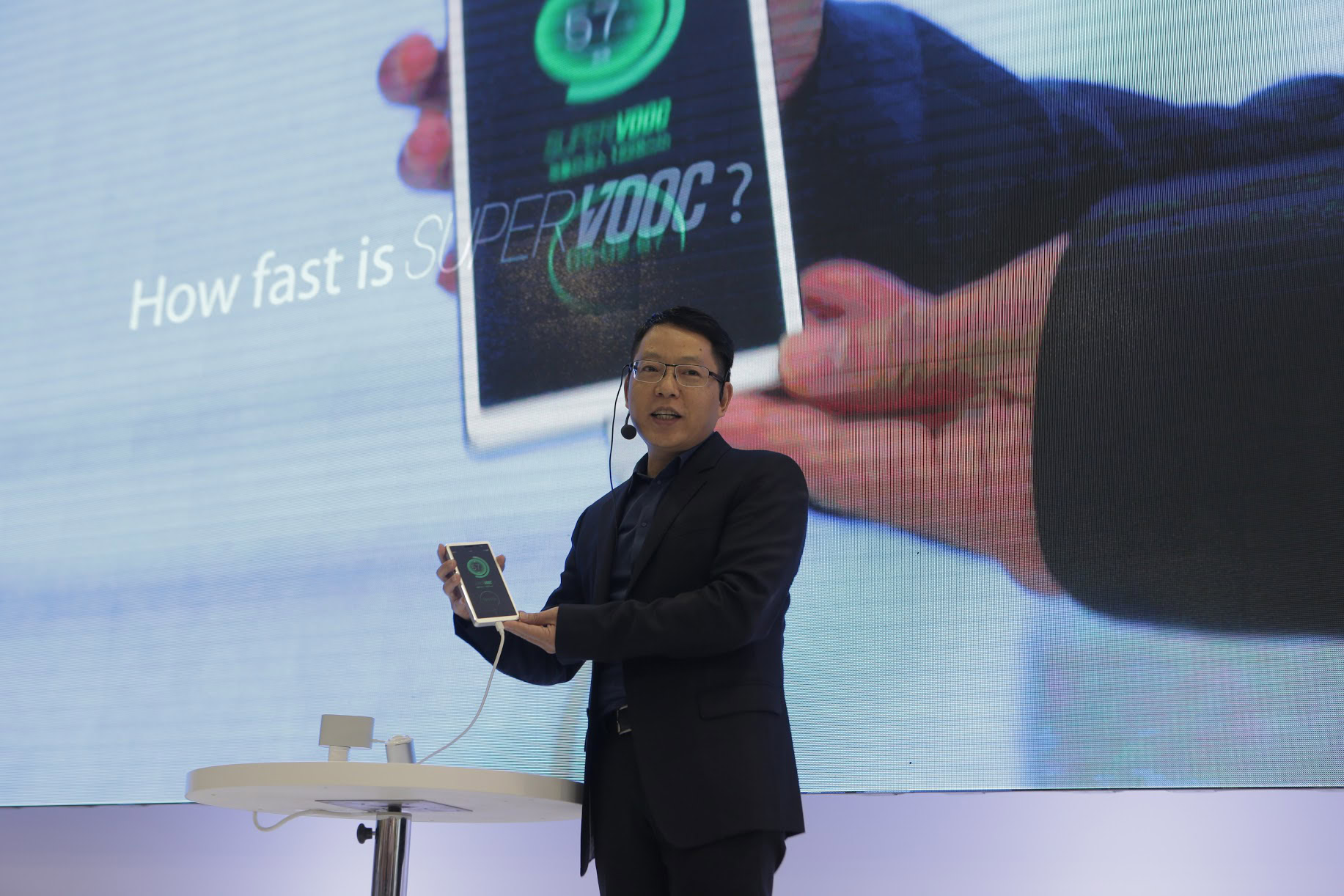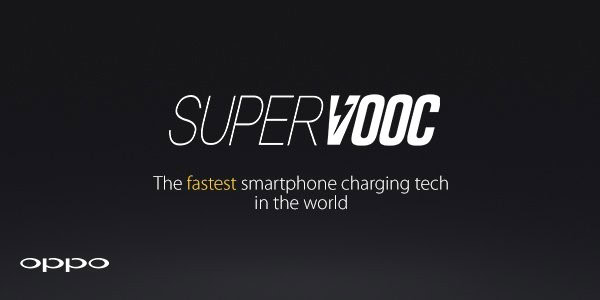Affiliate links on Android Authority may earn us a commission. Learn more.
Oppo's Super VOOC Flash Charge will top-up smartphone batteries in just 15 minutes!


As mobile devices have evolved over the years and become the powerful handheld computers that exist today, one of the key limiting factors has, is, and will continue to be, battery-related shortcomings. The larger the screen, the higher the resolution, the faster the SoC, the end result is always the same: low battery warnings. Developments like wireless Qi charging and Qualcomm’s Quick Charge 2.0 technology have made things easier, but still require time to top-up.
At Mobile World Congress here in Barcelona, OPPO has unveiled a new solution to the problem. Called Super VOOC Flash Charge, the technology is still in the early stages of development however it will ultimately allow smartphones to reach 100% battery charge in just 15 minutes.
The development will inevitably be limited in use to OPPO-devices, however there is a chance it could be licensed for broad usage from OEMs around the world. It will be available in both Micro-USB and USB Type-C configurations.

Essentially, Super VOOC Flash Charge delivers a constant 5V of power. This will allow, for example, a 2500mAh battery to reach 45% capacity in around 5 minutes. According to OPPO’s press release:
By applying a newly developed low-voltage pulse-charge algorithm, along with OPPO’s customized battery, multiple technical innovations, as well as first-class hardware and software, Super VOOC Flash Charge can bring your device to a 45% charge in just five minutes of charging (for a 2500 mAh battery). This means that a full charge can be achieved in just 15 minutes! With Super VOOC Flash Charge technology, users can talk for 10 hours after just 5 minutes of charging.The newly innovated low-voltage pulse-charge system, coupled with OPPO’s customized battery, dynamically regulates the current, ensuring a safe, sustainable charging experience and preventing overheating. The Super VOOC Flash Charge adapter, cable and connector have all received a full redesign using premium and extremely reliable military-grade materials. Super VOOC Flash Charge supports Micro-USB and USB Type-C, in line with the global standard.
As indicated in the above press release excerpt, OPPO explains that all components of the charging process are to be made with “premium and extremely reliable military-grade materials” from the power adapter, to the cable to the connecting port itself located in the phone. It will remain to be seen which of its devices will be compatible with the technology.
The Chinese OEM currently plans to release a device with Super VOOC Flash Charge in the latter part of the year.
Full press release follows:
[press]
Allowing users to fully charge their phones in just 15 minutes, OPPO has released its latest technology — Super VOOC Flash Charge!
By applying a newly developed low-voltage pulse-charge algorithm, along with OPPO’s customized battery, multiple technical innovations, as well as first-class hardware and software, Super VOOC Flash Charge can bring your device to a 45% charge in just five minutes of charging (for a 2500 mAh battery). This means that a full charge can be achieved in just 15 minutes! With Super VOOC Flash Charge technology, users can talk for 10 hours after just 5 minutes of charging.
The newly innovated low-voltage pulse-charge system, coupled with OPPO’s customized battery, dynamically regulates the current, ensuring a safe, sustainable charging experience and preventing overheating. The Super VOOC Flash Charge adapter, cable and connector have all received a full redesign using premium and extremely reliable military-grade materials. Super VOOC Flash Charge supports Micro-USB and USB Type-C, in line with the global standard.
VOOC Flash Charge
VOOC Flash Charge was developed as a result of one of OPPO’s main concerns about smartphone development. While the smartphone industry is fast-moving, the lithium-ion battery has not changed much since its creation, even though its high power consumption and endurance often leave users wanting more. Battery endurance has now become the biggest bottleneck restricting smartphone development. Meanwhile, battery capacity is constantly increasing. And with it, charging times are getting longer and longer. To offer consumers a better user experience, high-capacity batteries need to be matched with faster charging speeds. OPPO therefore zeroed in on this problem and developed VOOC as a result.
It took OPPO three years to develop the low-voltage, fast-charging technology that is VOOC Flash Charge. A totally independent undertaking, OPPO has already applied for 18 patents related to VOOC alone. Capable of charging four times faster than ordinary chargers, VOOC is the fastest and most secure smartphone charging technology.
VOOC Flash Charge was offered with OPPO’s Find 7 in March 2014. With a 3000 mAh battery, the Find 7 supports two hours of talk time after just five minutes of charging with VOOC, and its power reaches 75% after 30 minutes, sufficient for a day’s use. (This data is based on laboratory tests; actual charging may differ due to factors such as battery capacity and temperature, while actual call time can also be affected by the device state and real-life environment.)
With its creative solution to the issue of battery endurance, VOOC Flash Charge won praise from users and the media. In less than two years since its introduction, OPPO smartphones featuring VOOC Flash Charge saw sales exceed 17 million units in the Chinese market. VOOC Flash Charge’s innovations led it to win 8 science and technology media awards internationally.
Technology Release Timeline
Version 1.0: On March 19th, 2014, when standard smartphone charging was still applying 5V1A, OPPO pioneered VOOC Flash Charge.
Version 1.1: Half a year after its release, VOOC Flash Charge speeds continued to lead the industry. OPPO then launched a VOOC Flash Charge power bank and VOOC Flash Charge car charger. Reducing the size of the original by half, VOOC Mini Power Adapter was introduced with the launch of the N3 and R5.
VOOC Flash Charge’s Technical Principle
VOOC Flash Charge added an intelligent MCU chip (flash core) in the adapter in order to achieve revolutionary voltage open-loop and multi-stage, constant-current charging. VOOC Flash Charge creatively changes circuit topologies, meanwhile creates an all-side, five-level protection technique from the adapter to the interface as well as the device, securing the safety as well as the speed.
Low Voltage VOOC Flash Charge Advantages
The VOOC charging voltage is in line with the standard smartphone charging voltage of 5V. This means that the power can be directly transmitted to the battery without any voltage conversion, allowing the process to attain a charging efficiency of up to 97%. High-voltage fast charging, however, requires conversion to a lower voltage to supply power to the batter. This means a loss of energy and a lowered charging efficiency of about 85%.
Because of the difference in charging mechanism and efficiency, the temperature of a smartphone using VOOC Flash Charge remains significantly lower during the charging process than a phone using a high-voltage solution. VOOC Flash Charge-enabled devices will heat up by a maximum of only 3.3. degrees Celsius.
Because temperatures can be regulated so effectively during charging with VOOC Flash Charge, the smartphone can safely be used during the charging process. For instance, you can Flash Charge your smartphone while surfing the Internet, watching videos, or playing games. However, if you try to use your smartphone while using another fast-charging technology, the charger will revert to a standard charging speed, due to the temperature spikes caused by quick charging and screen brightening simultaneously.
[/press]